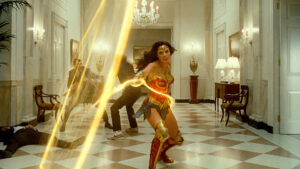All I Want for Christmas Is: No Zoom
Posted on December 25, 2020 at 10:00 am
Posted on December 22, 2020 at 4:18 pm
A-| Lowest Recommended Age: | 4th - 6th Grade |
| MPAA Rating: | Rated PG for some language and thematic elements |
| Profanity: | Mild language |
| Alcohol/ Drugs: | None |
| Violence/ Scariness: | Issues of life and death |
| Diversity Issues: | Diverse characters |
| Date Released to Theaters: | December 25, 2020 |

We are human because we ask those questions. And the answer to that second one is: In part to make movies like this one, to explore what makes life worthwhile.
Joe is a jazz musician. At least, that’s what he is in his heart, what he wants to be, what he thinks he was born to be. But what he is at the moment is a high school music teacher trying to make teenagers’ instruments sound less screechy and more on key. And then (this is still in the first minutes of the movie) he gets the chance of his dreams. A former student named Curly (Questlove) invites Joe to to audition for saxophonist Dorothea Williams (Angela Bassett). Joe takes a risk by adding his own ideas to Dorthea’s music, and she agrees to let him join her on stage that night. It’s everything he ever hoped for.
That’s why he is not paying careful attention as he walks home, and so he falls into a sewer and dies. We’re still in the first minutes of the film.
Instead of The Great Beyond, Joe ends up in The Great Before, where young souls prepare to be born. Joe thinks this could be his opportunity to return to earth and become the musician he knows was his reason for being alive. The counselors who guide the little souls think he is a mentor, and assign him to their hardest case, known as 22 (Tina Fey). Mentors like Lincoln, Mother Teresa, and Gandhi have all failed to persuade her. So we have one character who will do anything to get back to life on earth and one who refuses to go because she doesn’t see the point.

The counselors look like Calder wire sculptures. They are all named Jerry. And they have a diverse range of voices, including Wes Studi, Fortune Feimster, and Richard Ayoade. Why do they look and sound like that? Because they are too complex for humans to comprehend, they have created these simple, accessible forms.
That’s what all story-tellers try to do, what stories are for, and what Pixar has done here: they take very complicated characters and themes and make them accessible to us. When they do it right, we cry. And then we continue to think about what they illuminate for us. If they do it right, we are enlarged by it, as the characters are. This is Pixar, so it will make you laugh, think, and cry, and then think some more. And because it is Pixar the art, from the character design to the real and imagined settings are believable and enthralling. The sublime jazz music is from Jon Batiste and the score is from top team Trent Reznor and Atticus Ross (also heard this year in “Mank” and “Watchmen”).
Co-writer/co-director Kemp Powers (screenwriter of one of December’s other best films, “One Night in Miami”) was one of many Black voices brought in to make sure the film is authentic to the lived experience of Black people for two reasons. First, they wanted Black audience members to recognize the characters and the experiences. Powers encouraged the addition of one of my favorite scenes in the film, the barbershop owned by Joe’s friend Dez (Donnell Rawlings). Co-writer/co-director Pete Docter is exploring what happens to us after we survive growing up, as in his now-classic “Inside Out.”
We learn from Joe’s interactions with Dez and Curly that he is so caught up in music and his fear of not realizing his dream of playing “Black improvisational music” that he does not really listen to others. (An encounter later on with another student helps him begin to realize that even people who are not a part of his “real” life have something to tell him.) And we learn before Joe does that just because we have a dream does not mean it is the only dream or the best dream.
There are so many ideas and insights and so much music in “Soul” that it rewards several viewings. In The Great Before, each soul waiting to be born visits the Hall of You, to pick up individual personal qualities, like being excitable or aloof. They can give the soul the what and the who, but the why is something they have to discover for themselves. There is a sort of no-man’s-land for people who operate outside the rules of The Great Before, including a pirate shipped manned (so to speak) by people like Moonwind (talk show host Graham Norton) who is still alive on earth but through meditation communes with the universe. There are many lovely touches in the details, like the pre-credits “When You Wish Upon a Star” played by Joe’s students.
Joe and 22 end up back on earth, chased by a celestial accountant named Terry (Rachel House) trying to bring them back to The Great Before. Can Joe get to the performance after all? Can 22 find some reason to live as a human? (You don’t have to be an existential philosopher to agree with her that pizza is pretty great.)
We’ve all seen a lot of movies with heroes who seek and find their one true purpose. Many are based on real life, about people who became successful and famous ins spite of doubters. There are always those who nag them to do something else and we are supposed to see them as short-sighted and selfish. “Soul” wants us to see more than that, and it shows us how to begin.
Parents should know that this movie concerns life and death and a character is killed in an accident early in the film and then goes to The Great Before. There is some mild language and some cartoon-style peril.
Family discussion: What would you see in the Hall of You? What would you tell 22? How has this year made you think about what is important?
If you like this, try: “Inside Out” and “Everybody Rides the Carousel”
Posted on December 21, 2020 at 9:31 pm
Many thanks to two dear friends, Tim Gordon and Charles Kirkland, for inviting me on Keeping it Reel to talk about the best films of 2020.
Posted on December 21, 2020 at 8:00 am
B-| Lowest Recommended Age: | Middle School |
| MPAA Rating: | Rated PG-13 for violence and sequences of action |
| Profanity: | None |
| Alcohol/ Drugs: | Social drinking |
| Violence/ Scariness: | Extended comic book/action-style peril and violence, sad death |
| Diversity Issues: | None |
| Date Released to Theaters: | December 25, 2020 |
| Date Released to DVD: | March 30, 2021 |

The first Wonder Woman was exceptionally well-conceived and executed, a triumph for director Patty Jenkins after some lackluster films from DC Comics. The WWI setting added interest, especially seeing Diana’s response to learning about the world outside of her idyllic woman-only community of Amazonian warriors. The stakes were clear and compelling and the villain was genuinely scary.
This sequel, set in 1984 for no particularly compelling reason, has entertaining moments and fun action sequences but the stakes are not as visceral and the villains are not as interesting.
As a resident of the Washington DC area, I got a special kick out of the re-creation of the 1980’s look of Georgetown and some of the other locations and tried not to pay too much attention to the details they got wrong. I can promise you, no one who works at the Smithsonian would think of touching any of their artifacts without gloves and other protective equipment, much less letting anyone, even a major contributor who knows how to flirt, take one home. But that is what happens when an item with crystals ends up at the Smithsonian Museum of Natural History, where Diana (Gal Gadot) is now working as an expert.
Now, I’m not asking for realism in a genre that includes radioactive spider bites and infinity stones, but ideally the McGuffin (Hitchcock’s term for whatever it is the story is about — the formula, the gold, the nuclear codes, whatever) has to be simple enough not to interfere with the plot but specific enough to make the threat interesting, and that means we have to understand a little bit about how it works, why it is important, and what it takes to defeat it. It’s more fairy tale than comic book, a wishing stone crystal thingy more like “be careful what you wish for” stories like The Monkey’s Paw (which gets a shout-out in the film) or King Midas’ power to turn all he touched to gold.
That’s not a very good McGuffin and the villains are disappointing, too. There is a guy who has informercials about how to be rich on television, Maxwell Lord played by guy-behind-the-Mandelorian-helmet Pedro Pascal, who wants, well, pretty much everything. Making him in the oil business is a nice 80’s touch. And there’s the mousy museum curator Barbara Minerva (Kristin Wiig), who wants to be just like Diana. The muddled elements of their storylines are reflected in an absurd flashback that is supposed to make us, what, feel sorry for him? Understand his “Cat’s in the Cradle” problem? And the Capra-esque conclusion is not the “we are the world” moment they hope for.
Then there’s Chris Pine as Steve Trevor. As you may remember, he died heroically in the first movie. So there’s a real “Bobby Ewing in the shower” moment (another 80’s reference?) to bring him back. I’m all for putting Chris Pine in every movie ever, but again, the way this happens is not thought all the way through and it is impossible not to feel uneasy about the way the characters overlook the real-world consequences of his return for so much of the storyline. I did get a kick out of having the guy do the trying on clothes montage, though, for once. And the post-credit appearance from a most-welcome addition to the cast.
Gadot is an enormously appealing screen presence but this storyline is not a good fit with her abilities as an actress or a movie star. This is a sadder, wiser Diana, more than 60 years after the first film, but at times she just seems emptier.
Maybe it’s just been too long since I’ve seen a comic book movie, but I found it entertaining despite all of the narrative shortcomings. Just hoping the next chapter is more wonder-ful.
Parents should know that this movie has extended comic book/action-style peril and violence and a sad death.
Family discussion: Why didn’t Max spend more time with his son? Did Diana envy Barbara?
If you like this, try: “Wonder Woman” and the DC Comics. Adult fans will enjoy Jill Lepore’s The Secret History of Wonder Woman, about the remarkable story of the man who created the character.